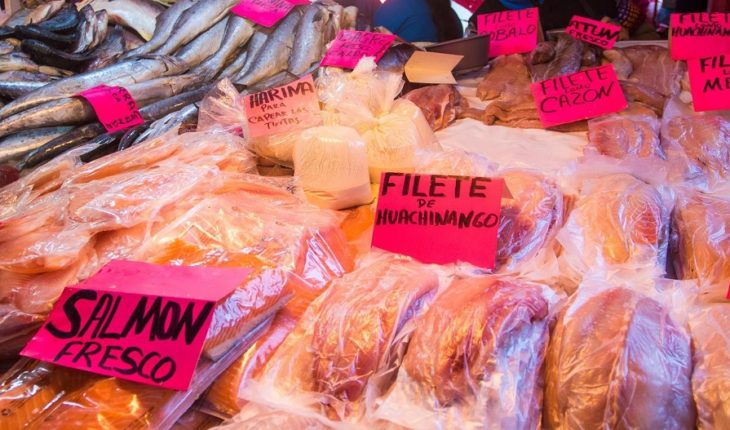Mrs. Alejandra Nieto has been shopping in the same super corner of her colony for more than ten years, in the Mayor Cuauhtémoc of Mexico City.
He comes here, explains the veracruzana woman of 61 years, at least once a week to buy fish and seafood with which she prepares chipotle shrimp broths and toast, grilled fish fillets – sometimes huachinango, sole, or tilapia, as the pocket permits-, and baked mojarrasarras with green sauce and yellow cheese.
Now, with the beginning of Lent, the veracruzana is buying some tilapia fillets in bulk and a couple of kilos of imported shrimp, to prepare a fish of the veracruzana, with tomato and black olives.
It’s not fresh fish like the one you buy when you visit your native Veracruz, says the woman shrugs. But she says she is satisfied with the quality of the products that the supermarket fills her with.
However, what the woman does not know is that, for the fish she carries in her bag, she will pay in the box up to 30% more than it actually costs.
Alejandra is unaware that she’s being given cat for hare.
Or, to be more precise, you are paying for water at the price of seafood.
An ‘invisible’ fraud
Renata Terrazas, Oceana’s director of transparency campaigns, explains in an interview that, as with Ms. Alejandra, most Mexican consumers of frozen fish are victims of “fraud” without even realizing it.
This is precisely one of the conclusions reached by the new study published this Tuesday Oceana, a civil organization that already in March last year did other research on how fishmongers, restaurants and supermarkets in three different Mexican cities sold cheap fish making it pass by much more expensive species.
Now, in this new research, Oceana analyzed 82 samples of different domestic frozen seafood and imported from 10 supermarket chains in Mexico City, to determine the percentage of frosting included in these products through an engineer’s food analysis.
First of all, it must be explained that frosting is a preservation technique that is used in products already frozen previously, and that basically consists of applying a surface layer of frozen water that protects the product, in this case to fish and shellfish.
This technique is common and is enabled by the Food and Agriculture Organization of the United Nations (FAO).
But in Mexico there are three problems, renata Terrazas poses.
One, there is no regulation to determine how much icing should be included in each fish and/or shellfish. For this reason, in the samples of the study they obtained very different results: from fish with low icing percentages – such as national tuna, with just 4% – to shellfish such as imported shrimp with levels above 50%.
Two, most frozen fish products in Mexico do not inform the consumer what the percentage of frosting is. In fact, according to the Oceana study, 98% of the products they analyzed did not inform the final consumer that the fish was glazed.
And three, and this is where “fraud” is, the final price of the purchase does not inform or decount the weight of the icing. That is, the consumer is not paying for a net kilo of fish, but is paying for the weight of the fish, plus the weight of the frozen water that protects it.
Find out: You don’t know what you eat, the deception in the sale of fish in Mexico
To explain it with one example: Ms. Alejandra just bought a kilo of imported and frozen cooked shrimp at the supermarket, and paid a total of 427 pesos. However, you do not know that this product carries up to 30% of icing and that, in fact, you are paying with your money 70% net shrimp and that the remaining 30% is frozen water.
Or seen another way: Alejandra paid 298 pesos for 700 net grams of shrimp and disbursed up to 128 pesos for frozen water alone, equivalent to a minimum wage for a working day, or nine kilos of flour omelette, or about nine litres of fresh milk.
“Cat for hare”
“This is something that the consumer on foot doesn’t see or doesn’t have in his head when he goes to the supermarket. One, because we don’t know that frozen fish also brings an extra layer of water that protects it. And two, because he doesn’t know that they’re charging him as part of the net product, and that’s generating a gigantic distortion at the consumer’s expense,” Renata Terrazas said.
“I mean, it’s another way for you to be cated by hare. Pay for water at the price of seafood,” said Terrazas, who explained that the Oceana study abounds with the examples they documented from the analysis of the 82 samples.
For example, one kilo of national cazón cost 136 pesos a kilo. But after the food engineer analyzed the sample, Oceana’s research found that 17% of frosting was included in that price. That is, the consumer paid 113 pesos for 83% of the net product, and 23 extra pesos for that 17% of frozen water.
And “the deception” is even greater in imported products, since they need more icing for their preservation to reach our country in optimal conditions.
For example, a kilo of imported tilapia that cost 205 pesos carried 30% of glaze, so the final consumer should have paid 144 pesos for the 700 net grams of product alone, and had ‘saved’ 61 pesos frozen for water.
One kilo of imported mojarra cost 163 pesos and carried 22% of glaze. The consumer must have paid 30 pesos less.
A kilo of imported huachinango cost 455 pesos a kilo, with 17% frosting. The consumer must have paid 77 pesos less.
And a kilo of Alaskan fish cost 103 pesos, with 28% icing. He should have spent 28 pesos less.
Oceana’s director of transparency campaigns argues that this situation also implies “unfair competition” against the domestic product, since in many cases imported fish and seafood is offered at a lower price than the national one, but it ends up costing more because of the high percentages of water added through the icing.
Shark by marlin
Faced with the results of this research, Oceana put a proposal: the construction of a traceability policy and a legal framework that gives certainty to consumers of fish and shellfish about the conditions of the product being consumed.
And a first step in that direction, Renata Terrazas noted, would be that the labelling of frozen seafood clearly indicated what the percentage of frosting is, and that the consumer is charged only for the net weight of the product; that is, without the extra weight of the frozen layer.
“Right now, the reality is that we don’t know where that extra layer of water they’re selling us is added. We do not know if, in the case of imports, you already leave the country of origin with the icing, or if it is applied when you arrive in Mexico, or if supermarkets do,” Terrazas said.
“That’s why we need a legal framework, a control, and a certainty that the products were legally, sustainably, sustainably caught, that they went through the right conservation processes, and that nothing was added to it at the end consumer’s expense,” the Oceana member stressed.
And for all of the above, he added, it is necessary the involvement of conapesca, as an authority that looks after the health of the Mexican seas, but also of other authorities that look after the right of consumers to prevent other frauds of the sea, such as the sale of cheap species by posing as more expensive ones.
Precisely, Mrs. Alejandra Nieto said that, although she was not aware that she is paying more money for her fish because of the glaze, what she has noticed is that on multiple occasions she has wanted to give cat for hare, especially in fresh products that are sold in the supply squares.
For example, he recently says that he bought a kilo of supposed national robbery, that it can cost 500 pesos a kilo, and that they actually gave him the “gatazo” selling him mojarra, which is at a much lower price: about 90 pesos a kilo.
In March last year, Oceana also published a study on this deception that not only affects the pockets of end consumers, but also has environmental impacts on the country’s fishing dynamics and maritime ecosystem.
The study, which was then made in 133 establishments, among fishmongers, supermarkets and restaurants in Mexico City, Cancun and Mazatlan, in Sinaloa, shows how in Mexico it is common the practice of replacing fish with which, just to mention a case, while diners choose marlin what they actually receive most of the time is smoked tuna.
Although, even, the study documented that on two occasions the marlin was replaced by fox shark, and in one by silky shark.
Oceana’s research also showed cases in which it was sold, when in fact it was based, a much cheaper species. Or huachinango that was actually flag catfish.
Read Oceana’s full research on the frosting here:
What we do in Animal Político requires professional journalists, teamwork, dialogue with readers and something very important: independence. You can help us keep going. Be part of the team.
Subscribe to Animal Politician, receive benefits and support free journalism.#YoSoyAnimal





